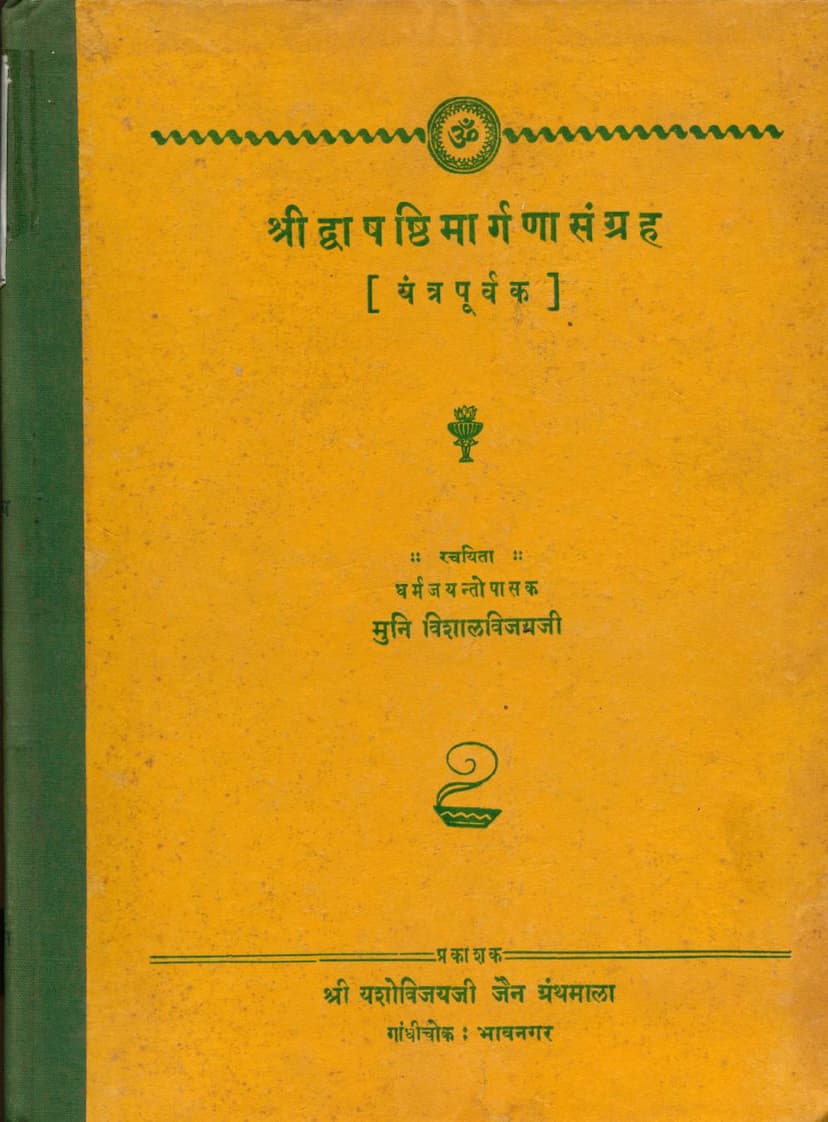Dwashashthi Margana Sangraha
Added to library: September 1, 2025

Summary
This is a comprehensive summary of the Jain text "Dwadasashthi Margana Sangraha" by Vishalvijay, based on the provided pages and catalog link.
Book Title: Dwadasashthi Margana Sangraha (द्वाषष्टि मार्गणा संग्रह) Author: Muni Vishalvijay (मुनि विशालविजय) Publisher: Shri Yashovijay Jain Granthamala, Bhavnagar (श्री यशोविजयजी जैन ग्रंथमाला, गांधी चौक, भावनगर) Catalog Link: https://jainqq.org/explore/022686/1
Overall Purpose and Content:
"Dwadasashthi Margana Sangraha," which translates to "Collection of Sixty-Two Paths/Classifications," is a significant Jain text that delves deeply into the principles of Jain philosophy and doctrine, particularly concerning the classification and understanding of the soul's journey and its various states. The book is meticulously structured, presenting a vast array of classifications, known as "mārgāṇā," which are essential for understanding the nuances of Jain metaphysics and ontology.
The primary aim of the text is to provide a systematic and comprehensive overview of the 62 marganās, which are essentially categories or modes of existence and experience for the soul. These marganās are analyzed across 83 different "dwāras" (aspects or points of investigation). The author, Muni Vishalvijay, has undertaken this massive task with great diligence, drawing heavily from ancient Jain scriptures and commentaries.
Key Aspects and Structure:
The book is an exhaustive compilation that systematically explores the various aspects of the soul's existence and its manifestations. The core of the work lies in the detailed examination of 62 marganās through the lens of 83 dwāras. These marganās are fundamental categories used in Jainism to understand the nature and states of living beings (jivas). The dwāras provide specific analytical frameworks for each marganā.
Illustrative Examples of Dwāras and Marganās (as seen in the content):
The extensive table of contents (pages 26-45) reveals a highly detailed structure, covering a wide range of concepts. Some of the key dwāras (aspects of analysis) examined in relation to the marganās include:
- Jiva Dwara (जीवद्वार): The nature and classifications of the soul, including its 563 types (based on hellish beings, inferiors, humans, and deities).
- Gunasthan Dwara (गुणस्थान द्वार): The 14 stages of spiritual development.
- Upayoga Dwara (उपयोगद्वार): The functions of knowledge and perception.
- Yoga Dwara (योगद्वार): The types of activities of mind, speech, and body.
- Leshyā Dwara (लेश्याद्वार): The six subtle states of the soul's disposition.
- Karma Dwara (कर्मद्वार): The classification of karmic bondage and liberation.
- Pudgala Dwara (पुद्गलद्वार): The nature and aspects of matter.
- Bandha Dwara (बंधद्वार): The process of karmic bondage.
- Nirjara Dwara (निर्जराद्वार): The shedding of karmas.
- Bandha Hetu Dwara (बंधहेतुद्वार): The causes of karmic bondage.
- Punya Bandha Prakriti Dwara (पुण्यबंध प्रकृतिद्वार): The causes and nature of meritorious karmic influx.
- Paap Bandha Prakriti Dwara (पापबंध प्रकृतिद्वार): The causes and nature of sinful karmic influx.
- Aasrava Dwara (आश्रवद्वार): The influx of karmas.
- Samvara Dwara (संवरद्वार): The stoppage of karmic influx.
- Moksha Dwara (मोक्षद्वार): Liberation.
- Various States: The text delves into detailed classifications based on states like sentient/non-sentient (संज्ञि/असंज्ञि), those who take food (आहारी/अणाहारी), birthplace (योनि), body types (शरीर), and more.
- Kashayas (कषाय): The four primary passions (anger, pride, deceit, greed) and their sub-classifications.
- Vedas (वेद): The three types of existence (masculine, feminine, neuter).
- Samyakva (सम्यक्त्व): The three types of right faith (upashamika, kshayopashamika, kshayika).
- Drishti (दृष्टि): The three viewpoints (mithyā, samyak, mishra).
- Sangraha (संज्ञा): The four types of cognitions (āhāra, bhaya, mithuna, parigraha).
- Dhyāna (ध्यान): The four types of meditation (ārta, raudra, dharma, śukla).
Author's Background and Dedication:
The book is a testament to the author's deep scholarship and devotional dedication to Jainism. Muni Vishalvijay is a disciple of Muni Jayantvijayji, who himself was a disciple of the renowned Acharya Vijaydharm Surishwarji. The author has also authored other significant works, such as "Subhashita Padyaratnakara." The text is dedicated to his Guru, Muni Jayantvijayji, recognizing the profound influence and guidance received. The preface also expresses gratitude to various individuals and organizations that supported the publication.
Structure and Presentation:
The "Dwadasashthi Margana Sangraha" is presented in a highly organized manner. It begins with an "Arpan" (dedication), followed by a "Prakashak nu Nivedan" (publisher's note), and the author's "Sampadakiy Vakyavya" (editor's discourse). The core of the book is the detailed exposition of the marganās and dwāras, often presented in tabular or list formats, making complex information accessible. The inclusion of "Shuddhipatrak" (errata) and extensive references to Jain scriptures indicates the author's commitment to accuracy and scholarly rigor. The preface highlights the author's journey in compiling this work, starting from his studies under esteemed gurus and progressing through various stages of research and compilation.
Significance:
This work is considered invaluable for scholars, students, and practitioners of Jainism, particularly for those interested in the deeper aspects of Jain logic, metaphysics, and karma theory. It serves as a comprehensive reference manual, offering a structured approach to understanding the soul's journey through its various states and classifications. The detailed analysis of 62 marganās across 83 dwāras provides a unique and profound insight into the vastness of Jain knowledge. The book's publication in Gujarati, making it accessible to a wider audience, is also a significant contribution to Jain education.